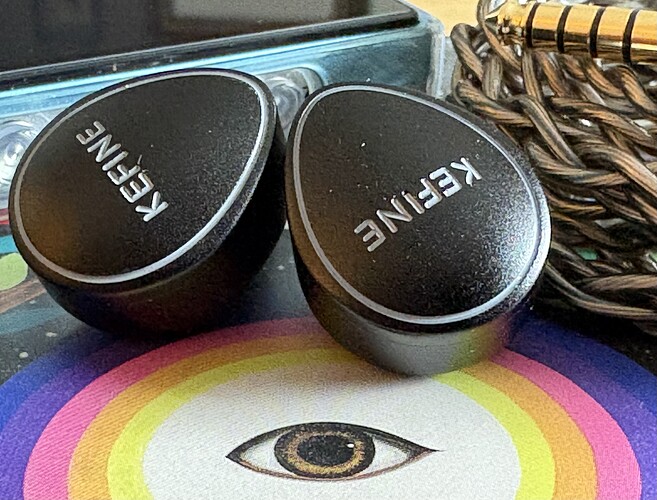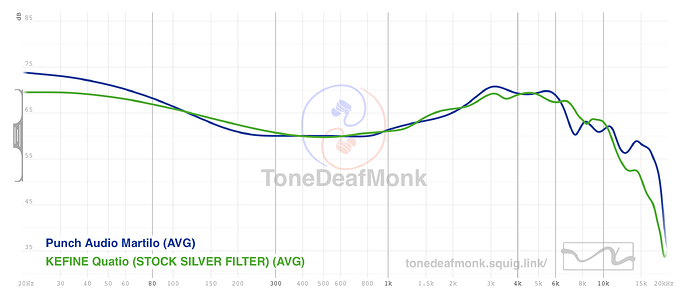Tanchjim Fission – A Feature-Packed IEM with DSP Flexibility
Pros
- Very flexible (in terms of sound)
- Inclusion of type-c plug
- Beautiful and professional aesthetics.
- Great fit and comfort
- Great build quality
- Stock analogue tuning is great.
- DSP sound profiles are also great, especially the default and popular ones
- DSP implementation is very good.
- Tanchjim App UI is good.
Cons
- Stock tips are not the best
- No hard shell carry case
- Only one tuning nozzle makes a change in sound
- Bass adjustment mechanism does not offer meaningful changes
- App is not directly available on Play Store
Specs And Driver Configuration
- Driver configuration : 1DD (DMT 5th gen)
- Sensitivity: 108dB/mW
- Impedance: 16±10%Ω
- Shell Material: Aluminium Alloy
- Price: $130
Before starting the review, I want to thank Tanchjim for sending this iem for a review.
Accessories Package
The accessories provided are good. Things provided in the box are 1. Cable with replacement 3.5mm and type-C plug 2. A carry pouch 3. 2 Tuning nozzles 3. Narrow and wide bore tips.
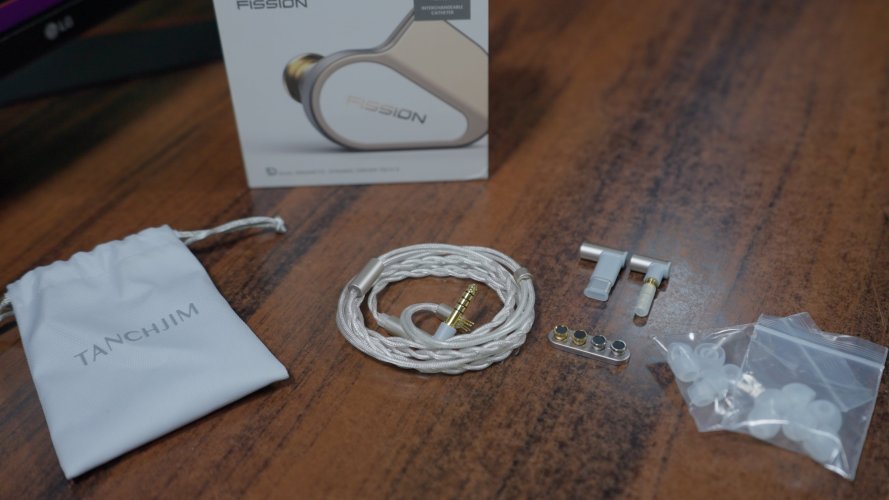
For the price, the biggest miss is the lack of a proper carry case. A soft pouch just doesn’t cut it at this price point; they should’ve included a small hard case instead. That said, the cable is a big improvement over past Tanchjim sets. The colourway matches the Fission really well. The interchangeable plug system uses a friction-fit style. A big plus is the inclusion of the Type-C jack in the box, it adds a lot of flexibility to the sound. I’ll talk more about that later. As for the eartips, they’re decent but nothing special. Tanchjim could’ve gone with better ones, something like the T300 tips would’ve made a big difference.
Aesthetics and Build Quality
The aesthetics of the Fission are on point, it looks very classy and professional. If you’re not a fan of loud or flashy faceplate designs, you’ll definitely appreciate this one. The light champagne gold colour paired with the white glass faceplate looks excellent.
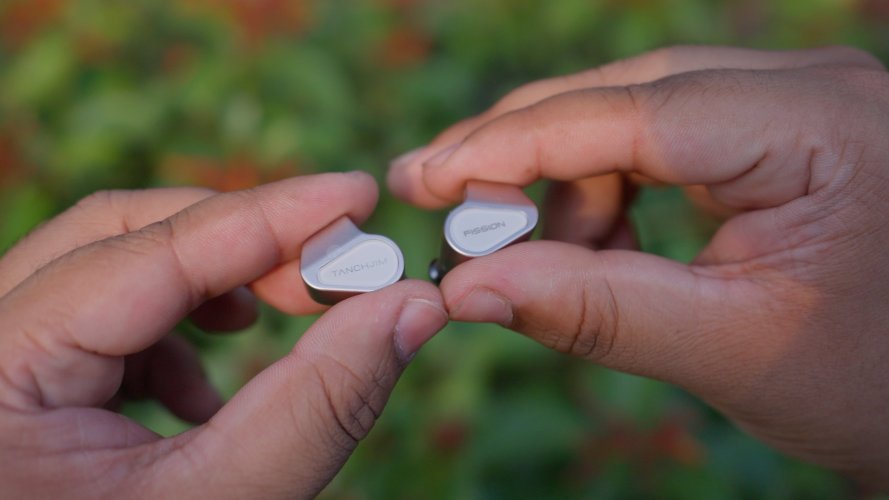
The build quality lives up to the looks too. It’s built really well. The aluminum alloy shells feel robust and sturdy, and the glass faceplate adds a touch of premium feel. Despite being full metal, the shells aren’t too heavy or unwieldy, they strike a perfect balance between durability and comfort.
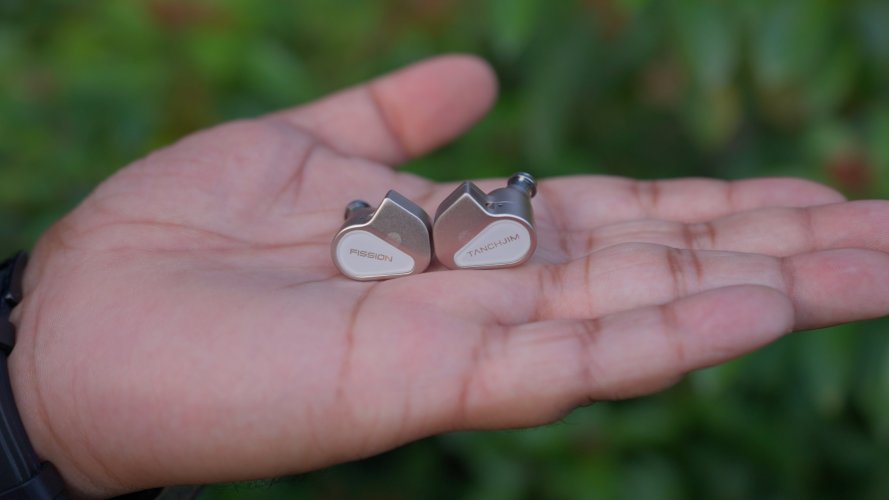
Fit and Comfort
The fit and comfort of the IEM are excellent, The shells are on the small side with a medium sized nozzle so they fit quite snugly in the ear. They also sit very flush in the ear so, you can wear them while lying down as well. The fit is very stable as well. Comfort is top-notch too, there’s nothing in the shell design that pokes or causes discomfort, so I can wear them for hours without any issues.
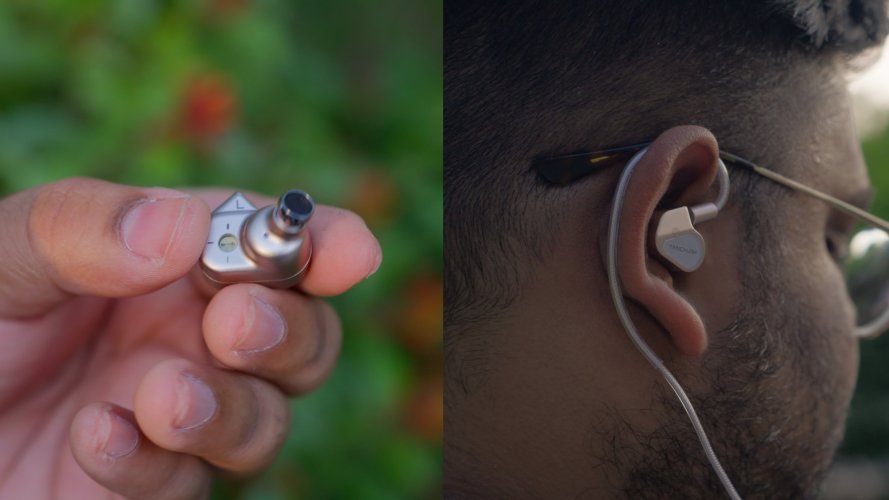
Sources Used
I used fiio JM21, onix xi1 and fiio retro nano all of them drove the fission without any issues. It is fairly easy to drive to drive so you don’t need to worry about sources. If you have decent dongle dac you are golden.
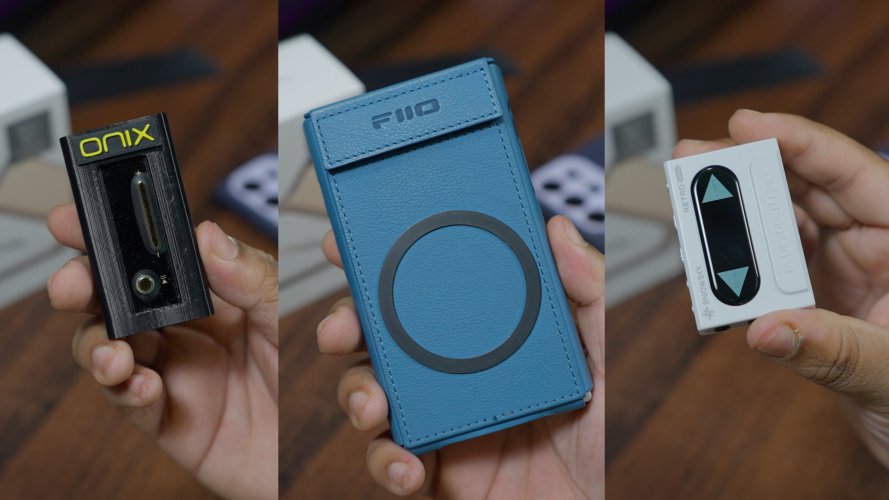
Sound
For my sound testing, I used the Final e-type tips. There are a lot of tuning options available, honestly maybe even too many. First, in analogue mode, you have the tuning nozzles, and on top of that, dip switches. Then there’s DSP mode, which offers its own set of tuning profiles. It’s a lot to take in, and while the flexibility is impressive, it can feel a bit overwhelming at first.
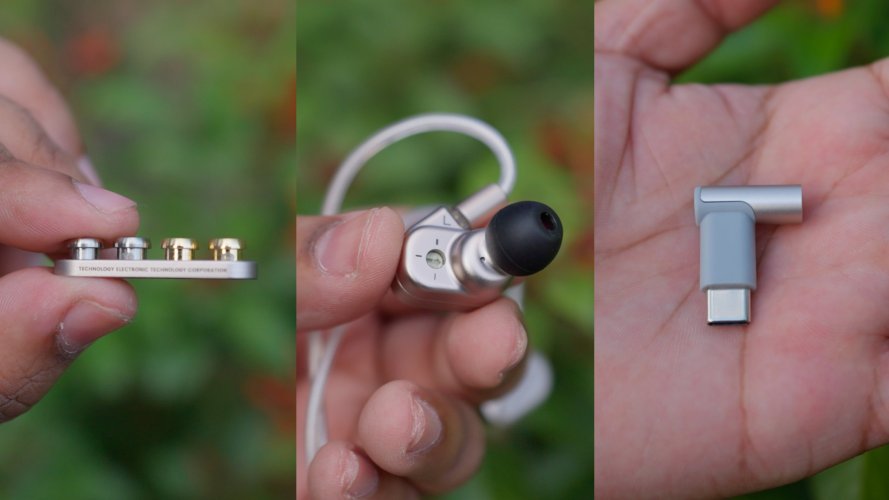
Analog Mode
The stock sound signature of the Fission is vocal-focused. You can tweak it slightly using the included tuning nozzles. The “T” nozzle reduces bass and adds a bit more energy in the upper mids. The “C” nozzle, on the other hand, doesn’t really do much, consider it more of a spare.
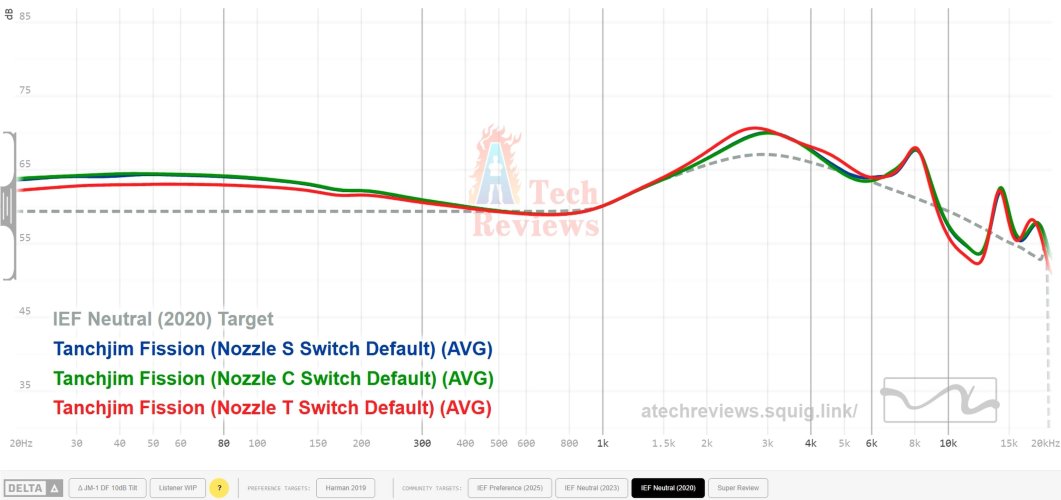
Then you have the tuning switches, which offer four settings, 1. Default 2. Pop 3. Monitor 4. Natural. All of these settings reduce the bass to varying degrees.
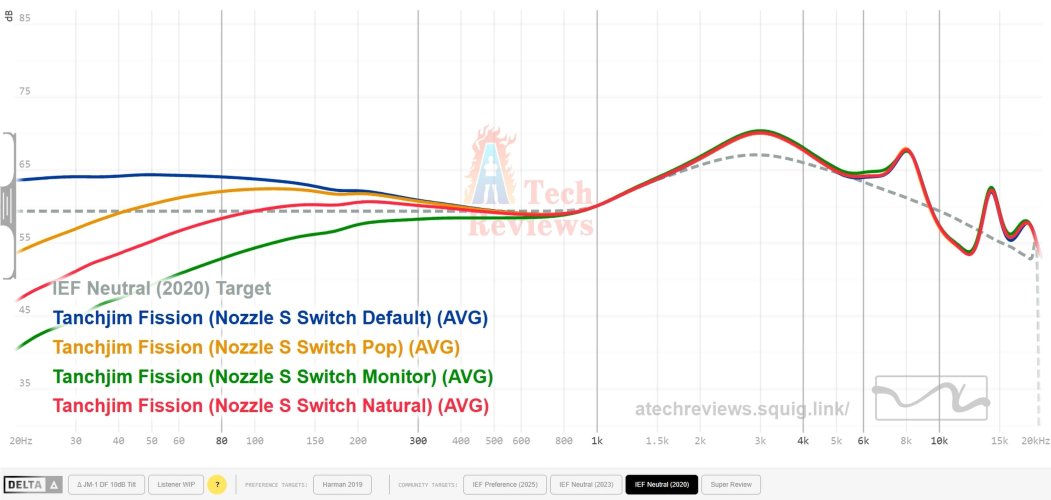
Personally, I didn’t enjoy any of these modes, they cut the bass too much for the music to sound natural or enjoyable to my ears. I honestly wish they had skipped the bass-reducing switches and instead included nozzles that made a more noticeable and useful impact on the overall sound.
For my analog mode testing, I used the stock nozzle and kept the tuning switch set to default.
Bass
The bass in analog mode more about quality than quantity. If you’re someone who prefers strong, dominating bass, this might not be the IEM for you. The bass gradually rises from the sub-bass to the mid-bass region. However, the graphs don’t tell the whole story here, you can hear a bit more bass than what the graphs might suggest. This is all thanks to the very good bass dynamics and punch. The attack of the bass is also well-defined.
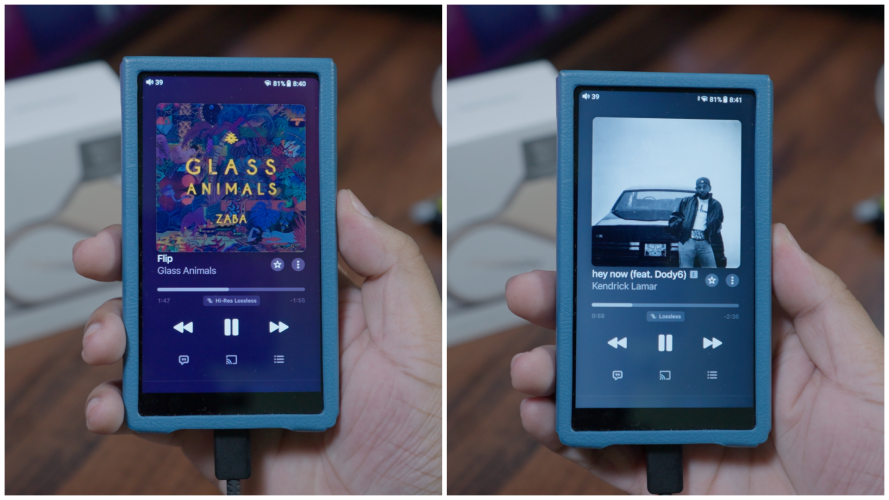
The sub-bass delivers a nice rumble and texture, while the mid-bass is punchy and tactile in its presentation. This type of bass tuning works perfectly for ballads and vocal-centric libraries, where the focus is more on clarity and dynamics rather than overwhelming bass. Personally, I would have liked slightly more sub-bass to make this IEM better suited for genres like hip-hop and EDM. Overall, no major complaints.
Mids
In my opinion, the mids are the star of the show on this IEM. They are well-textured and shine beautifully. The mid-bass transitions gradually into the lower mids, giving them a nice sense of heft and body. Fission has good note weight. The upper mids are well-extended and open without ever sounding harsh or shouty. The presence region is perfectly tuned, adding just the right amount of edge and detail to the upper mids. Vocals, in particular, sound sublime on this IEM you can put on a vocal-centric track, sit back, and just relax. Male vocals have a satisfying heft, making them sound authoritative and powerful, while female vocals, though slightly on the husky side, are equally excellent. Vocalists like Adele and Michael Bublé sound absolutely sublime on this IEM. Instruments also come across as very natural, complementing the vocals perfectly.
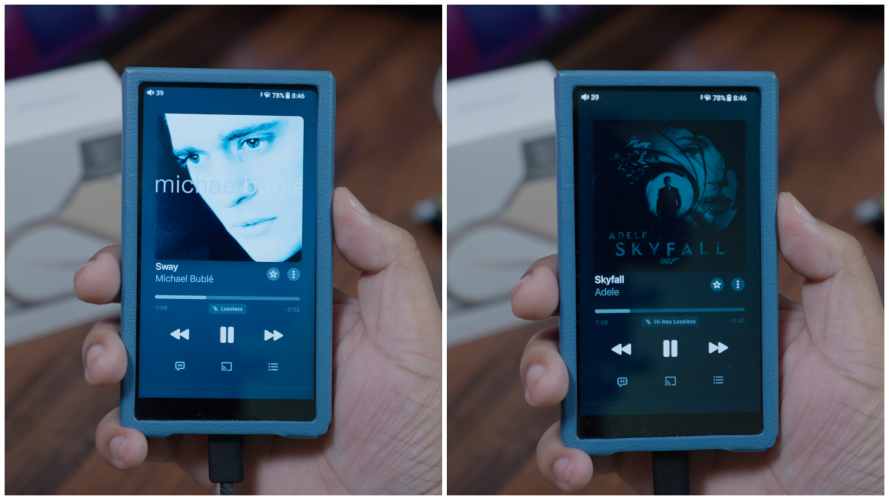
Treble
The treble on the Fission is also well executed. It’s smooth, well-extended, and tastefully done. There’s none of the grit or roughness that some dynamic drivers can exhibit, which is a big plus. The treble makes its presence known; it’s not subdued or overly mellow, but it stays clear of sibilance or harshness. It has a nice bite and a sense of incisiveness that adds energy to the presentation. The treble extension is particularly impressive, bringing a good amount of air and openness to the overall sound.
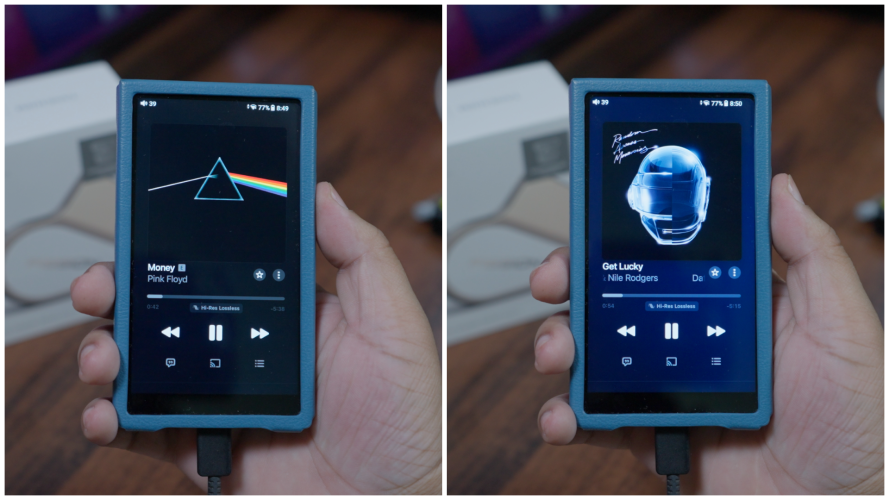
Detail Retrieval and Technical Performance
The detail retrieval and overall technical performance are good, nothing groundbreaking, but definitely solid for the price. Micro-detail retrieval is good; it picks up subtle nuances in the track quite well. Macro-detail is also well-handled, with a good sense of dynamics and punch. In terms of technicalities, it performs right where I’d expect for its price point. The technical performance is also what I would expect for the price. Stage has good width, not the widest in the segment, but better than Kima 2. Imaging, layering and instrument separation are also good.
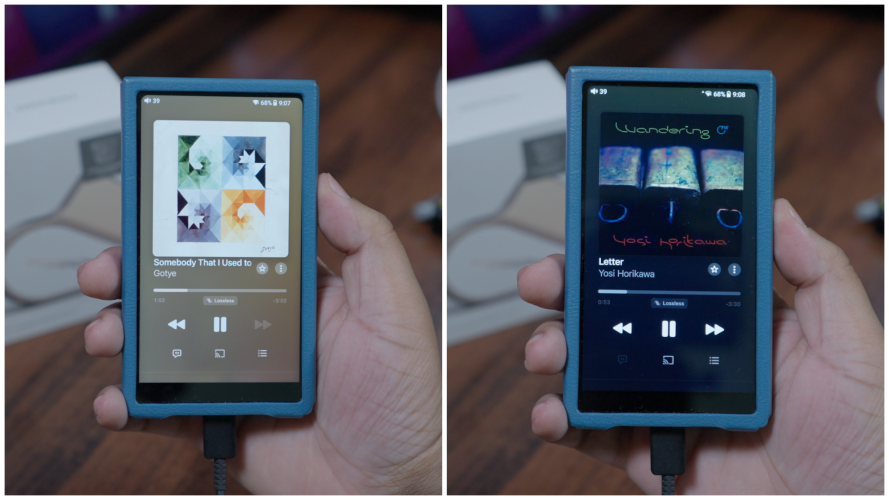
DSP (Type-C) Mode
The inclusion of the Type-C DSP connector is, in my opinion, the real value-add here. It makes the Fission truly flexible for those who enjoy experimenting with different sound profiles and diving deep into EQ customisation.
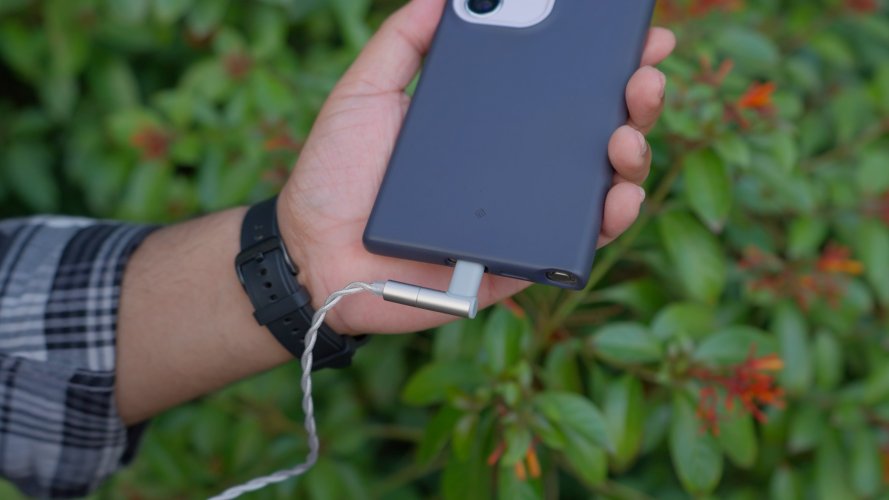
The DSP implementation itself is excellent. The built-in DAC sounds clean, with no noticeable artefacts or noise floor issues. Power output is also sufficient; I never had to push the volume too high to reach my usual listening levels.
The companion app has improved a lot since I last used it a year ago. However, the main issue is accessibility: it’s not directly available on the Play Store. Instead, you have to download it from Tanchjim’s website. Worse, when you try to install it, Google Play Protect blocks it, and you have to manually disable Play Protect to proceed. That’s not a great look. Tanchjim should definitely make the app available directly through the Play Store for easier and safer access.
Once installed, the app offers five DSP profiles 1. Default 2. Neutral 3. Balance 4. Popular 5. Musical. I personally liked the Default and Popular profiles the most. The app also includes dedicated gaming EQs, making it a strong option for gaming. Additionally, there’s a full 5-band parametric EQ for those who want to fine-tune their sound. There’s even an EQ sharing forum, where you can upload your own settings or try out profiles created by others. This kind of functionality really turns the Fission into a Swiss Army knife of the IEM world.
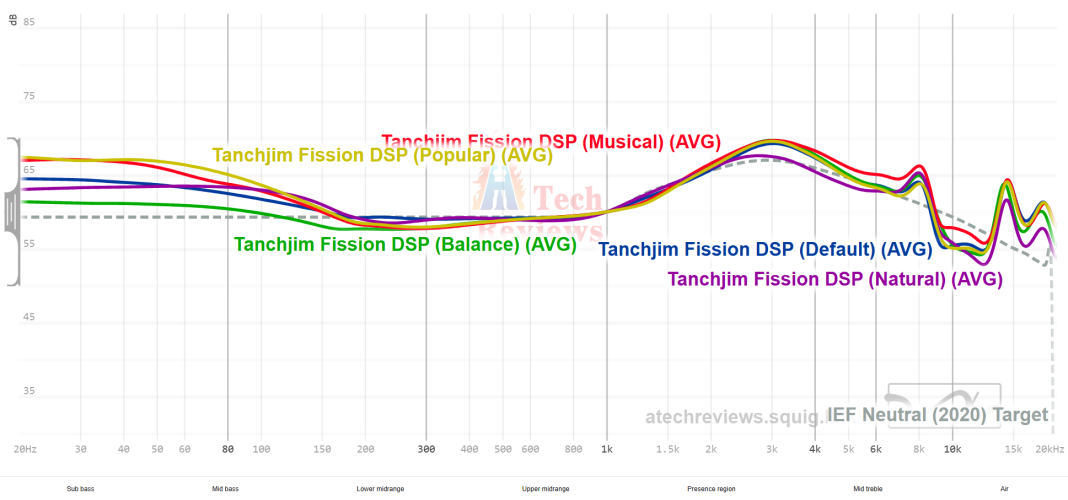
Now, moving on to sound, the Default profile is neutral with a very mild sub-bass boost. The Popular profile, on the other hand, is more V-shaped, offering a substantial bass lift. The Fission’s driver handles this tuning effortlessly, with no signs of strain.
In the Popular profile, the bass becomes significantly more fun and engaging. Rather than a smooth bass slope, the tuning here is more of a shelf, which results in a clear separation between the bass and lower mids. Sub-bass rumble is excellent, and mid-bass thump is impactful and satisfying. The lower mids remain clean and well-separated, though they do lack the heft and body present in analogue mode. Upper mids stay very similar to the analogue tuning, while the treble is slightly dialled back but even more smoother. Overall, I find this profile especially enjoyable for genres like pop, hip-hop, EDM, and rock.
Fission Analog vs Dunu Kima 2
If you’re looking for a single dynamic driver IEM under $150, you’re likely also considering the Kima 2 as well. So let’s do a quick comparison between the two.
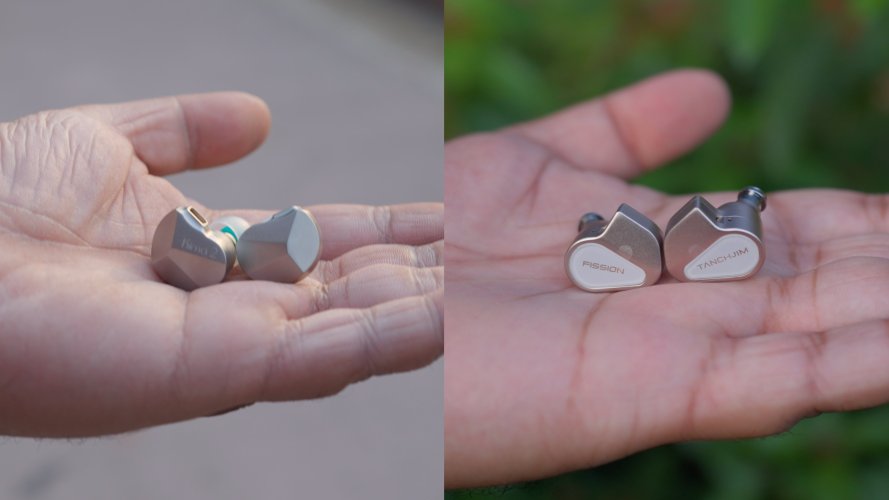
In terms of accessories, DUNU clearly takes the win. The stock accessories package is excellent, with everything from the carry case to the cable and especially the eartips feeling premium and thoughtfully chosen, far better than what you get with the Fission.
When it comes to build quality, both excellent and are made of metal. They have good heft to them. Both feel very sturdy and robust, so tie here,
In terms of fit and comfort, personally, I liked the fit of the fission better as its shell is smaller and fits more snugly in the ear. In terms of comfort, both are very good, and I can wear both of them for hours without any issues.
Sound-wise, the two have some subtle differences. The Kima 2 has a more relaxed and laid-back tuning compared to the Fission. The bass quality is better on the Fission, it’s tighter and hits with more authority. Lower mids are similar on both, but the Kima 2 has slightly more relaxed upper mids and a softer, more laid-back treble. When it comes to technical performance and detail retrieval, the Fission pulls ahead with a wider stage, better imaging, and more precise layering.
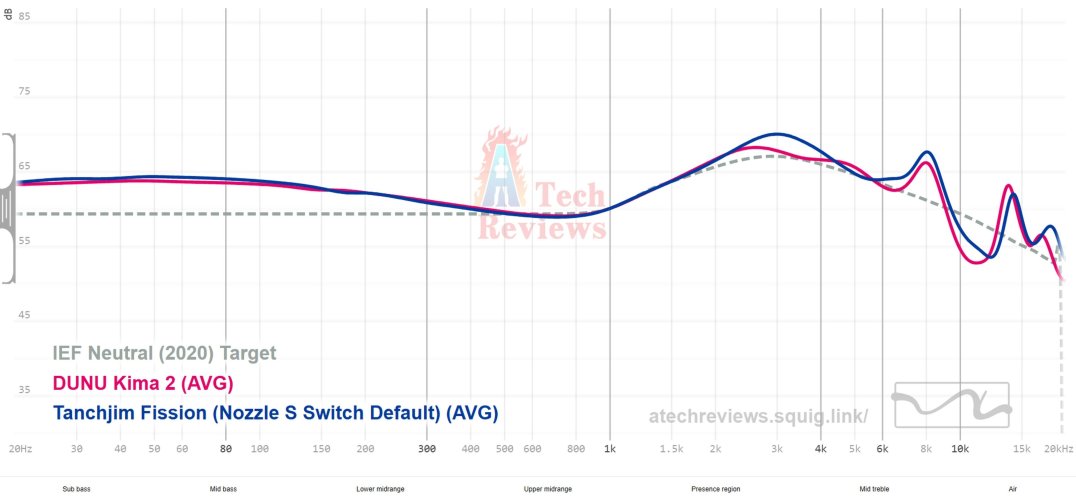
One big advantage the Fission is the DSP mode. With multiple preset profiles and a full parametric EQ available through the app, it offers a lot more flexibility for people who enjoy tuning their sound. You can tailor the experience to your liking, which adds a lot of value.
So, all things considered, while both are strong contenders in this price range, the Fission edges out the Kima 2 for me thanks to its better technical performance, improved bass, and the added versatility from the DSP features.
Conclusion
Tanchjim has created a great set with the fission, it is very versatile and has alot of things for you to tinker with to get your ideal sound. I really appreciate the inclusion of type-c jack in the box, inclusion of this makes this set truly flexible and versatile. But, I think they have over done few things which makes the overall experience complicated at times. The bass adjustment switches don’t offer any meaningful improvement and could honestly be removed altogether.
The Nozzles also provide very minimal changes that too only the T nozzle provides a change. They should have put more effort in th nozzles. And the exclusion of a carry is a bummer as well.

The stock tuning and the flexibility that type-c plug provides are the biggest selling point of this iem. In my opinion, this is one of the best sounding single DD available under 150 dollars and it dethrones my previous recommendation the Kima 2 from its spot.
If you’re new to the hobby and not quite sure what kind of sound you prefer, the Fission is a fantastic place to start. And if you’re someone who enjoys playing around with EQs and tuning, this is definitely the IEM for you as well. Overall, it gets a solid thumbs up from me.

